Cepheid variable - Study guides, Class notes & Summaries
Looking for the best study guides, study notes and summaries about Cepheid variable? On this page you'll find 73 study documents about Cepheid variable.
Page 3 out of 73 results
Sort by
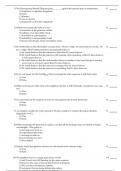
-
Exam 3B - Binghamton University ASTR 114 | Latest 2023-2024
- Exam (elaborations) • 9 pages • 2023
- Available in package deal
-
- $9.99
- + learn more
1) The Hertzsprung-Russell Diagram plots ________ against the spectral type or temperature. A) brightness or apparent magnitude B) mass C) distance D) size or density E) luminosity or absolute magnitude 1) 2) Which event marks the birth of a star? A) formation of the planetary nebula B) collapse of an interstellar cloud C) formation of a photosphere D) instability in an interstellar cloud E) fusion of hydrogen atoms into helium atoms 2) 3) Dr. Smith believes that the Hubble constan...
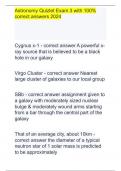
-
Astronomy Quizlet Exam 3 with 100% correct answers 2024.
- Exam (elaborations) • 34 pages • 2024
-
- $7.99
- + learn more
Cygnus x-1 - correct answer A powerful x-ray source that is believed to be a black hole in our galaxy Virgo Cluster - correct answer Nearest large cluster of galaxies to our local group SBb - correct answer assignment given to a galaxy with moderately sized nuclear bulge & moderately wound arms starting from a bar through the central part of the galaxy That of an average city, about 10km - correct answer the diameter of a typical neutron star of 1 solar mass is predicted to be approxima...
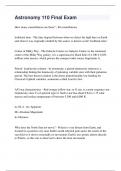
-
Astronomy 110 Final Exam
- Exam (elaborations) • 9 pages • 2024
- Available in package deal
-
- $15.49
- + learn more
How many constellations are there? - 88 constellations lookback time - The time elapsed between when we detect the light here on Earth and when it was originally emitted by the source, is known as the 'lookback time'. Center of Milky Way - The Galactic Center (or Galactic Centre) is the rotational center of the Milky Way galaxy; it is a supermassive black hole of 4.100 ± 0.034 million solar masses, which powers the compact radio source Sagittarius A. Period- Luminosity relation - In ...
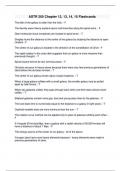
-
ASTR 205 Chapter 12, 13, 14, 15 Flashcards
- Other • 4 pages • 2023
- Available in package deal
-
- $10.00
- + learn more
The disk of the galaxy is older than the halo. - F The density wave theory explains spurs and branches along the spiral arms. - F Giant molecular cloud complexes are located in spiral arms. - T Shapley found the distance to the center of the galaxy by studying the distance to open clusters - F The center of our galaxy is located in the direction of the constellation of Orion - F The rapid rotation in the outer disk suggests that our galaxy is more massive than previously thought. - T S...

-
ASTR 1010 Final Vanderbilt; Questions And Answers
- Exam (elaborations) • 9 pages • 2024
-
- $12.39
- + learn more
ASTR 1010 Final Vanderbilt; Questions And Answers radioactive decay - answer -the process by which radioactive isotope breaks down into a stable isotope of same/another element; each half-life leaves half of existing population of radioactive isotope star cluster + special properties - answer -gravitationally bound stars formed from the same gas cloud; all about same dstnc from Earth, all about same age; open clusters have countable stars, globular clusters have too many to count (st...

-
BIG BANG GIZMOS-HUBBLE'S LAW WITH VERIFIED SOLUTIONS ALREADY GRADED A+
- Exam (elaborations) • 2 pages • 2023
- Available in package deal
-
- $15.49
- + learn more
Absolute brightness the intrinsic brightness of a star that depends only on its luminosity. Apparent brightness how bright a star appears to an observer on Earth. Mpc Astronomers describe the apparent brightness of a star as the ratio between the brightness of the star to the brightness of the Sun when viewed from a distance of 1 _____________ . For example, a star with an apparent brightness of 10 is 10 times brighter than the sun would be if viewed from a distance of 1 _______...
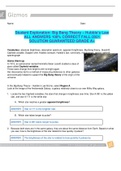
-
Student Exploration: Big Bang Theory – Hubble’s Law ALL ANSWERS 100% CORRECT FALL-2021 SOLUTION GUARANTEED GRADE A+
- Exam (elaborations) • 14 pages • 2021
-
- $11.99
- 8x sold
- + learn more
Vocabulary: absolute brightness, absorption spectrum, apparent brightness, Big Bang theory, blueshift, Cepheid variable, Doppler shift, Hubble constant, Hubble’s law, luminosity, megaparsec, period, redshift, spectrograph Gizmo Warm-up In 1912, an astronomer named Henrietta Swan Leavitt studied a class of stars called Cepheid variables. These stars change from bright to dim to bright again. Her discoveries led to a method of measuring distances to other galaxies and eventually helped to ...
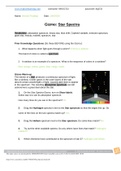
-
Gizmo: Star Spectra - 2023 All Answers are Correct
- Exam (elaborations) • 6 pages • 2023
-
- $7.99
- + learn more
Gizmo: Star Spectra Vocabulary: absorption spectrum, binary star, blue shift, Cepheid variable, emission spectrum, giant star, nebula, redshift, spectrum, star Prior Knowledge Questions (Do these BEFORE using the Gizmo.) 1. What happens when light goes through a prism? It forms a rainbow. This band of colors is called a spectrum. 2. A rainbow is an example of a spectrum. What is the sequence of colors in a rainbow? Red, orange, yellow, green, blue, indigo, violet. Gizmo Warm-up The inte...
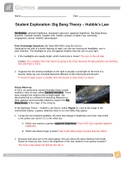
-
GIZMOS Student Exploration Big Bang Theory – Hubble’s Law (Answered 2021)
- Exam (elaborations) • 13 pages • 2022
- Available in package deal
-
- $10.49
- 1x sold
- + learn more
Vocabulary: absolute brightness, absorption spectrum, apparent brightness, Big Bang theory, blueshift, Cepheid variable, Doppler shift, Hubble constant, Hubble’s law, luminosity, megaparsec, period, redshift, spectrograph
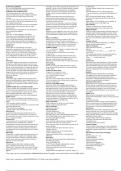
-
astr 115 final exam study guide | Detailed and Complete Solutions
- Exam (elaborations) • 2 pages • 2023
-
- $7.99
- + learn more
Hydrostatic Equilibrium The current distinguishing criterion between dwarf planets and small Solar System bodies Evolution of stars of different mass -Star formation produces a wide variety of stars -Only a few high-mass stars (O, B Type) are produced -The lowest mass stars (eg.M type) are the most common. -If a "star" forms with a mass less than about 1/10 the mass of the Sun, it will not have enough pressure in its core to ignite nuclear fusion. •The lower limit to the mass of a...

How did he do that? By selling his study resources on Stuvia. Try it yourself! Discover all about earning on Stuvia


